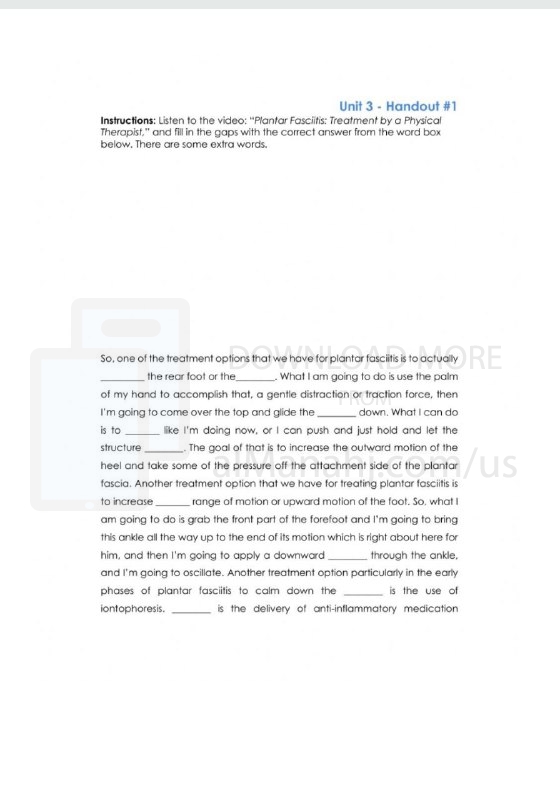| You are here: Almanahj Website ⇒ American curriculum ⇒ 12th Grade ⇒ Physics ⇒ Term 1 | ||
|---|---|---|
Worksheet about Physical Therapy | ||
|---|---|---|
| Subject: Physics | ||
| 12th Grade | ||
| Term 1 | ||
| Year: 2023/2024 | ||
| Size: 0 | ||
| Number of clicks: 136 | ||
| Publish date:November 06, 2023 | ||
| Added by: Eman | ||
| Last download date: 2024-09-12 00:29:50 | ||
| Updated by: Eman9966 on 2023-11-06 06:02:57 | By: theodor Christian Vega | |
| File info: Physical therapy, also known as physiotherapy, is a healthcare profession that focuses on improving and restoring physical function, mobility, and quality of life in individuals who have been affected by injury, illness, or disability. Physical therapists, or physiotherapists, are highly trained healthcare professionals who specialize in providing interventions and treatments to address physical impairments and promote optimal movement and function. The primary goal of physical therapy is to help individuals regain or maximize their physical abilities, reduce pain, and improve their overall well-being. Physical therapists utilize a combination of manual therapy techniques, therapeutic exercises, functional training, and other modalities to assess, diagnose, and treat a wide range of conditions. Physical therapy can be beneficial in various settings, including hospitals, clinics, rehabilitation centers, sports facilities, and home care. It is often prescribed as part of a comprehensive treatment plan by physicians, surgeons, or other healthcare providers. The process of physical therapy typically involves the following steps:1. Evaluation: The physical therapist performs a thorough assessment of the individual's physical condition, including their range of motion, strength, flexibility, posture, balance, and functional abilities. This evaluation helps to identify impairments, limitations, and specific goals for treatment. 2. Treatment Planning: Based on the evaluation findings, the physical therapist develops a personalized treatment plan tailored to the individual's needs and goals. The plan outlines specific interventions, exercises, and techniques that will be used to address the identified impairments and restore function. 3. Intervention: Physical therapy interventions may include a variety of techniques and modalities. These can include manual therapy, such as joint mobilization or soft tissue mobilization, therapeutic exercises to improve strength, flexibility, and endurance, balance and coordination training, gait training, pain management strategies, and the use of assistive devices or adaptive equipment. 4. Education and Self-Management: Physical therapists play a vital role in educating individuals about their condition, promoting self-care, and teaching techniques for managing symptoms and preventing further injury or disability. They may provide guidance on proper body mechanics, ergonomic principles, and strategies for maintaining a healthy and active lifestyle. 5. Progress Monitoring and Adjustment: Throughout the course of treatment, physical therapists continually assess the individual's progress and make necessary adjustments to the treatment plan. They may modify exercises, techniques, or goals based on the individual's response to treatment and their changing needs. Physical therapy can be beneficial for a wide range of conditions, including musculoskeletal injuries, neurological disorders, cardiovascular conditions, respiratory conditions, chronic pain, and post-surgical rehabilitation. It is also used in sports medicine to enhance athletic performance, prevent injuries, and facilitate recovery. Overall, physical therapy plays a crucial role in promoting physical health, restoring function, and improving the quality of life for individuals with physical impairments or limitations. Through a combination of hands-on interventions, therapeutic exercises, education, and support, physical therapists work collaboratively with individuals to help them achieve their functional goals and optimize their physical well-being. | ||
| File images |
|---|
 |